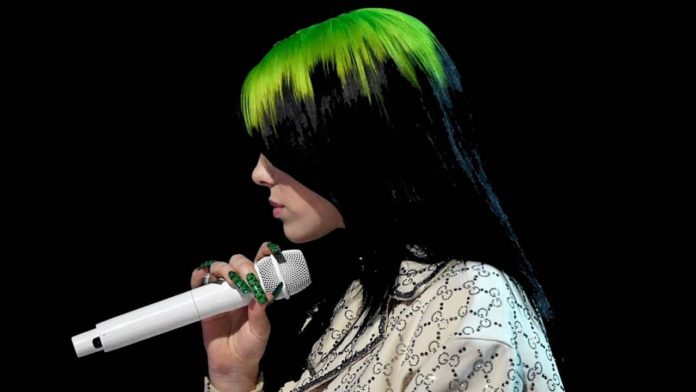Caitlin Klutz
Reporter
Since I have been sucked into the vast world of platform subscriptions like most people these days, I tend to get lost in homepages trying to find something enjoyable to watch so I can tune myself out of the world that is going on right now. Though I don’t know much about her, I thought I would give Billie Eilish’s documentary The World’s A Little Blurry a watch. I like documentaries, and I know that Billie Eilish has become a growing phenomenon for the last couple of years, so my curiosity got to me.
I can say, as a person with unbiased opinions regarding musical taste, I was blown away by the storytelling that this documentary portrayed.
Each element was well done—story progression, filmmaking, film setting, dialogue and scene snippets. There wasn’t a lot to dislike about this documentary. The film itself follows footage through the early stages of her career in 2015 all the way through her Grammy wins for her album, When We Fall Asleep, Where Do We Go? in early 2020. There are more than a few noteworthy messages shown in the film, along with quotes that stand out to me as a watcher.
The film begins with Eilish listening to one of her first songs on the radio in 2015. She was only 13 at the time. The footage used seems to be used from one of her family members’ phones, capturing the excitement Eilish has at the fact that her song is on the radio. The use of footage and equipment in this film switches back and forth from film cameras to phone/cheap cameras, as well as old home videos from Eilish’s childhood.
Much of this film revolves around Eilish’s personal life and dives deeper into her family as well. She describes her family as “one big (…) song.” Her father taught her how to play the piano and ukelele, her mother would accompany her with the guitar while she was singing and her brother Finneas played the piano, guitar, and ukelele as well. There’s a scene where Eilish is describing the vision she has for her upcoming music video When The Party’s Over. She has her mother outside with a table, chair and glass cup. As she’s filming on her phone, Eilish is working through what she wants to see in the video; black liquid in the glass, the exact film style, and angle, and she imagines the black tears. While this is happening, her father is going back and forth from the background, picking up their dog’s droppings in their yard, while the family dog is handing toys to her mom. The scene lets us into part of Eilish’s creative visions and experiences. It also lets the audience know that this is a family that is supporting Eilish’s dreams and visions as a normal family. It’s funny, but also raw and insightful.
Despite the fast-paced lifestyle, both her parents seem to show up frequently behind the scenes of shows, supporting her while they travel around the world for shows, providing snippets of wisdom, and physically helping her recover from injuries.
It’s revealed that she loved dancing as a younger girl, dancing around 12 hours a week. She had torn her hip flexor muscles, which completely ruined dancing for her. Even though this stopped her from dancing for a while, during performances she loves to jump and move around. She wants to show her audience that she’s enjoying herself by putting on a good show for them. In a way, she puts her fans first to give them a great experience but in turn does not take care of herself for the lifestyle she wants to display for them.
In multiple interviews (and if you’ve listened to her music) Eilish has revealed that a lot of her music is not particularly happy or cheerful.
“People are always, like, you know… ‘It’s so dark, have happy music…’” She says in an interview while traveling within shows, continuing with her reasoning, “I feel the dark things. I feel them very strongly, and, you know, why would I not talk about them?”
Though it’s easy to tell that a lot of her songs are about sadder moments in life, anxiety and depression, in this film we get to see the thought processes with these songs and their meanings behind the scenes. It’s not necessarily about making a statement about these emotions or feelings, but just being honest about what she was feeling while singing, co-writing, and writing these songs.
This film reminds you that despite the fame and fortunes that have followed Eilish in her career, she experienced the majority of this as a teenager. The hate comments that have targeted her are targeted at a teenage girl. That does not mean she is not stubborn or makes insensitive comments towards family, but she also tells them she loves them when ending a phone call or conversation. She hardly listens to her dad when he gives her a speech about driving safely but tells him she loves him very much. It doesn’t mean she doesn’t know how to own up to her actions—she is quite a grounded person who knows that her fame doesn’t make her better than anyone else. “Be the greatest you can be, but not greater than anyone else.”
If you are someone who is unsure about why Billie Eilish and Finneas O’Connell are famous, you should watch this film. If you’re someone who is unsure why teenagers and young folks are more easily depressed and anxious, you should watch this film. If you love music and documentaries, you should watch this film. If you feel in a rut about your own creativity or confidence about bringing your work into the world, you should watch this film. Basically, if you can, you should definitely watch this film.


















